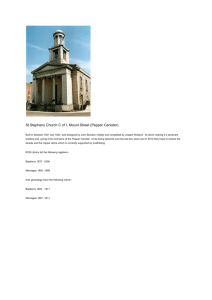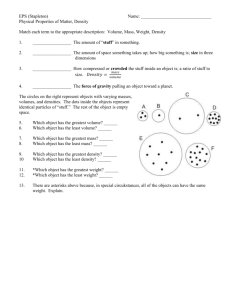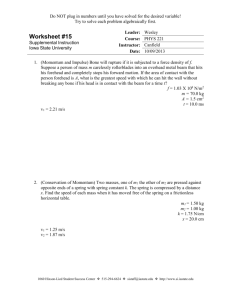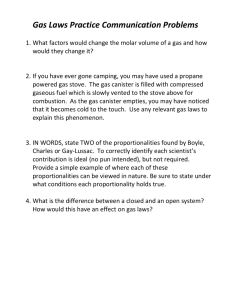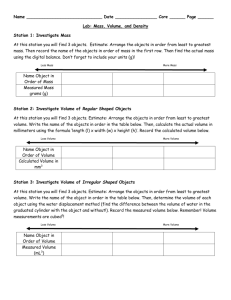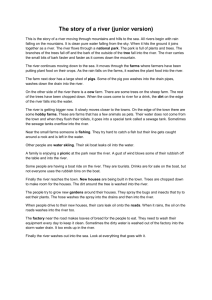EPPR-07-13e
advertisement
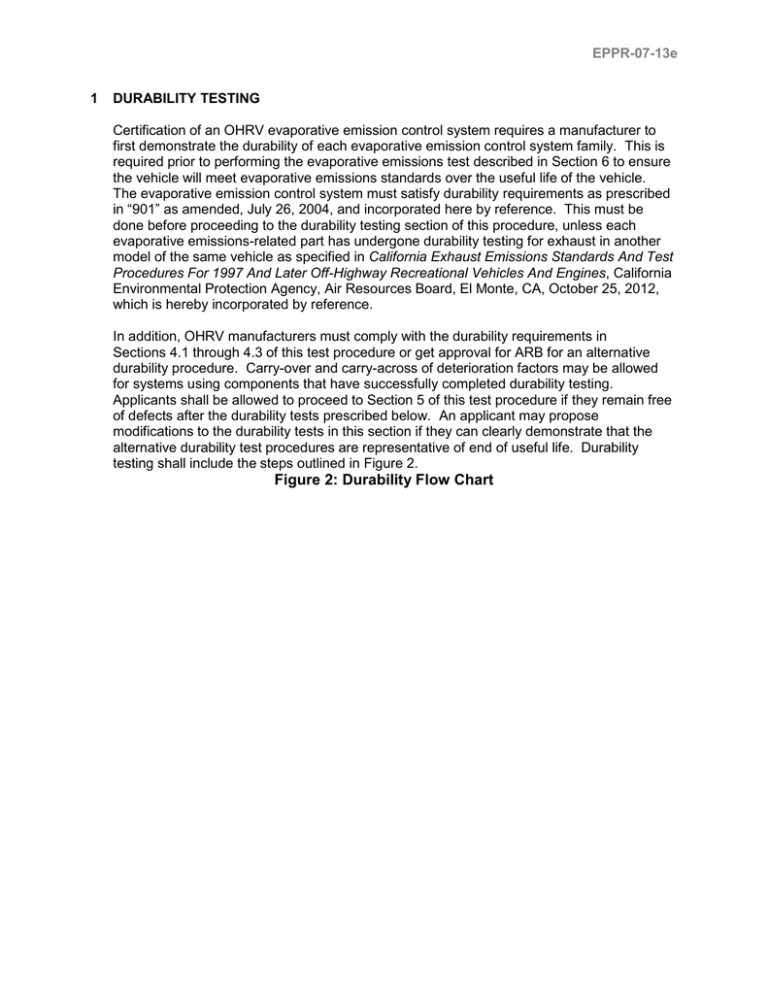
EPPR-07-13e 1 DURABILITY TESTING Certification of an OHRV evaporative emission control system requires a manufacturer to first demonstrate the durability of each evaporative emission control system family. This is required prior to performing the evaporative emissions test described in Section 6 to ensure the vehicle will meet evaporative emissions standards over the useful life of the vehicle. The evaporative emission control system must satisfy durability requirements as prescribed in “901” as amended, July 26, 2004, and incorporated here by reference. This must be done before proceeding to the durability testing section of this procedure, unless each evaporative emissions-related part has undergone durability testing for exhaust in another model of the same vehicle as specified in California Exhaust Emissions Standards And Test Procedures For 1997 And Later Off-Highway Recreational Vehicles And Engines, California Environmental Protection Agency, Air Resources Board, El Monte, CA, October 25, 2012, which is hereby incorporated by reference. In addition, OHRV manufacturers must comply with the durability requirements in Sections 4.1 through 4.3 of this test procedure or get approval for ARB for an alternative durability procedure. Carry-over and carry-across of deterioration factors may be allowed for systems using components that have successfully completed durability testing. Applicants shall be allowed to proceed to Section 5 of this test procedure if they remain free of defects after the durability tests prescribed below. An applicant may propose modifications to the durability tests in this section if they can clearly demonstrate that the alternative durability test procedures are representative of end of useful life. Durability testing shall include the steps outlined in Figure 2. Figure 2: Durability Flow Chart EPPR-07-13e Carbon Canister Test For systems that utilize a carbon canister, the durability test procedures shall include thermal cycling and vibration exposure of the canister. EPPR-07-13e 1.1.1 1.1.2 For thermal cycling, the test must subject the canister to 100 cycles of the following temperature profile: 1.1.1.1 Heat and hold at 140ºF 4ºF for 30 minutes. (Up to 10 minutes is allowed for the temperature to rise and stabilize) 1.1.1.2 Cool and hold at 32ºF 4ºF for 30 minutes. (Up to 20 minutes is allowed for the temperature to reach 32ºF during the cooling period) For the vibration test, the canister must be subject to a peak horizontal acceleration of 4.5 x gravitational acceleration (g – 9.8 meters per second squared) at 60 Hertz (Hz) with a total of 10,000,000 cycles. The orientation of the canister, while being subject to vibration, must be the same as when mounted on the vehicle during normal use. If the canister is mounted on the vehicle using a vibration isolation system, the canister may be mounted in a test rig using the same vibration isolation system for conducting the test. Pressure Vent Valve If the fuel system employs a fuel vapor pressure vent valve, prior to the time of submission of a certification application, the applicant is required to submit and obtain approval of an evaporative emission durability test procedure for the pressure vent valve. The procedure shall have provisions to demonstrate durability after exposure to ultraviolet (UV) light, ozone, vibration and dust. Once approved, the pressure vent valve durability procedure may be used by any applicant using a similar pressure vent valve. Carbon Canister Protection - Tip Test The carbon canister protection tip test can be conducted with a vehicle or with a test rig that represents the actual position and orientation of the fuel system components. The fuel tank must be filled to 100 percent of nominal capacity with certification fuel. 1.1.3 In less than 2 seconds, orient the vehicle such that the travel axis is tilted X degrees above and below the horizontal plane. See Figure 3 for a schematic. Hold the vehicle for 60 to 70 seconds, or such longer period of time as a manufacturer may choose, in both the positive and the negative position. X shall be as defined as follows: a) 30° ±2° for off-road motorcycles. b) 30° ±2° for all other OHRVs. EPPR-07-13e Figure 3: Horizontal Tilt 1.1.4 In less than 2 seconds, orient the vehicle such that the upright axis is tilted Y degrees from the vertical axis with rotation being about the travel axis. See Figure 4 for a schematic. Hold this position in both the positive and the negative position for 60 to 70 seconds, or such longer period of time as a manufacturer may choose. Y shall be as defined as follows: a) Unsupported position on either side for off-road motorcycles (i.e., vehicle lying on its side). b) 15° ±2° for all other OHRVs. Figure 4: Vertical Tilt The weight of the vehicle’s carbon canister must be measured before and after the tests specified in this section to determine weight gain. If the weight gain is 10 percent of the butane working capacity or more, the vehicle fails the test. Alternative carbon canister protection tip tests may be submitted for approval. All proposed alternatives to the carbon canister protection tip test must show that the carbon canister functions as it should at the end of useful life, while subjecting it to the potential for liquid gasoline contamination consistent with vehicle usage. As a guideline, EPPR-07-13e all alternative carbon canister tip tests should include real world liquid fuel exposure (e.g. volumes, rates, and total events), real world purges (e.g., rates and bed volumes), and use of a damaged canister during testing as described in this procedure. 2 EVAPORATIVE EMISSIONS SYSTEM PRECONDITIONING The purpose of the preconditioning period is to introduce test fuel into the fuel system and condition all fuel system components to in-use conditions. Evaporative system preconditioning can be done in conjunction with mileage accumulation for exhaust testing as long as the fuel system has continuously held evaporative test fuel E10 (Commercial Pump Fuel containing 10 percent ethanol) for a total 140 days. E10 pump fuel may only be used for the portion of the soaking period; however, fuel must be switched to E10 certification fuel for a minimum of 30 days prior to testing. The preconditioning procedure shall include the steps outlined in Figure 5. EPPR-07-13e Figure 5: Preconditioning Flowchart Start Evaporative Emissions Emission System Preconditioning (Section 5) Soak Fuel System Components (Section 5.1) Note: Section 5.2 Testing Must Occur During Section 5.1 Testing Precondition Carbon Canister (Section 5.2) End Evaporative System Preconditioning Soak Fuel System Components Precondition the tank and other fuel delivery system components by filling the tank to its nominal capacity with fresh test fuel. Cap the tank within one minute of filling. After filling the tank, start the vehicle engine and allow it to idle for approximately fifteen minutes. Soak the tank and other components continuously for a total of 3,360 hours while maintaining an ambient temperature between 68ºF and 86ºF. Alternatively, components may be preconditioned using a fuel system test rig. The test rig must include all the components of the fuel and evaporative emissions control system connected and oriented as they would be installed in the vehicle. The tank and fuel lines must be filled with certification fuel at the beginning of the test. A fuel system may be soaked for less than 3,360 hours if data is provided using one of the following two documents incorporated by reference: “TP-901 - Test Procedure for Determining Permeation Emissions from Small Off-Road Engines and Equipment Fuel Tanks” adopted July 26, 2004 or 40 CFR §1060.520 which was adopted on October 8, 2008 that shows steady state permeation has been reached. If slosh testing is required, the slosh time may be considered part of the preconditioning period, provided all fuel system components tested remain filled with fuel, and are never empty for more than one hour over the entire preconditioning period. If the fuel system is allowed to sit more than 6 weeks at 68°F to 86°F, a 1-week presoak must be conducted with fresh fuel before testing begins. The fresh fuel presoak can be counted as part of the 3,360-hour soak, so long as the fuel system is empty less than one hour. Prior to beginning any test sequence to measure running loss, hot soak, or diurnal emissions, a vehicle may, at the manufacturer’s option, be preconditioned to minimize non-fuel emissions by being soaked at an elevated temperature prior to testing. To EPPR-07-13e ensure steady state permeation rates, the vehicle must be soaked for at least 7 days at a temperature no higher than 95°F immediately prior to emissions testing. Precondition Carbon Canister For systems that utilize carbon canisters, Subsections 5.2.2 through 5.2.4 of the preconditioning sequence must be completed no sooner than 96 hours preceding the beginning of the evaporative emission test procedure described in Section 6 at 86° ±3°F. For vehicles with multiple canisters in a series configuration, the set of canisters must be preconditioned as a unit. For vehicles with multiple canisters in a parallel configuration, each canister must be preconditioned separately. If production evaporative canisters are equipped with a functional service port designed for vapor load or purge steps, the service port shall be used to precondition the canister. The following steps shall be performed in preconditioning the carbon canister: 2.1.1 2.1.2 2.1.3 2.1.4 Determine the canister's nominal working capacity based on the average capacity of no less than five canisters. These five canisters shall be the same as the canister on the vehicle undergoing testing. A manufacturer may use the butane working capacity provided by the canister vendor; if the vendor certifies that the working capacity has been determined using the following procedures: a) Each canister must be loaded no less than 10 times and no more than 100 times, to 2 gram breakthrough with a 50/50 mixture by volume of butane and nitrogen, at a rate of 15 ±2 grams butane per hour per liter of canister volume. Each canister loading step must be preceded by canister purging with 300 canister bed volume exchanges at 0.8 cubic feet per minute (cfm) per liter of canister volume. b) Each canister must first be purged with 300 canister bed volume exchanges at 0.8 cfm per liter of canister volume. The working capacity of each canister shall be established by determining the mass of butane required to load the canister from the purged state so that it emits 2 grams of hydrocarbon vapor; the canister must be loaded with a 50/50 mixture by volume of butane and nitrogen, at a rate of 15 ±2 grams butane per hour per liter of canister volume. Prepare the vehicle’s evaporative emission canister for the canister purging and loading operation. The canister shall not be removed from the vehicle, unless access to the canister in its normal location is so restricted that purging and loading can only reasonably be accomplished by removing the canister from the vehicle. Special care shall be taken during this step to avoid damage to the components and the integrity of the fuel system. A replacement canister may be temporarily installed during the soak period while the canister from the test vehicle is preconditioned. The canister purge shall be performed with ambient air of humidity controlled to 50 ±25 grains per pound of dry air. This may be accomplished by purging the canister in a room that is conditioned to this level of absolute humidity. The flow rate of the purge air shall be maintained at a nominal flow rate of 0.8 cfm per liter of canister volume and the duration shall be determined to provide a total purge volume flow through the canister equivalent to 300 canister bed volume exchanges. The bed volume is based on the volume of adsorbing material in the canister. The evaporative emission canister shall then be loaded by sending to the canister an amount of commercial grade butane vapors equivalent to 1.5 times its nominal EPPR-07-13e working capacity. The canister shall be loaded with a mixture composed of 50 percent butane and 50 percent nitrogen by volume at a rate of 15 ±2 grams butane per hour per liter of canister volume. If the canister loading at that rate takes longer than 12 hours, a manufacturer may determine a new rate, based on completing the canister loading in no less than 12 hours. The new rate may be used for all subsequent canister loading within this preconditioning. The time of initiation and completion of the canister loading shall be recorded.
